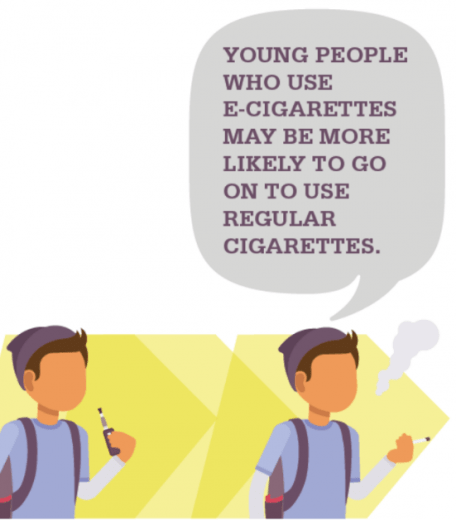 E-Cigarettes are electronic devices that heat a liquid (containing nicotine or other drugs) and produce an aerosol, or mix of small particles in the air. They come in many shapes and sizes; some look like regular cigarettes while others are disguised as everyday devices including USB flash drives, pens, credit cards or sweatshirt “hoodie” strings. Using an E-Cigarette is often called “vaping” or “Juuling.”
E-Cigarettes are electronic devices that heat a liquid (containing nicotine or other drugs) and produce an aerosol, or mix of small particles in the air. They come in many shapes and sizes; some look like regular cigarettes while others are disguised as everyday devices including USB flash drives, pens, credit cards or sweatshirt “hoodie” strings. Using an E-Cigarette is often called “vaping” or “Juuling.”
Most E-Cigarettes contain nicotine – the addictive drug in regular tobacco products. Research has shown nicotine to damage the adolescent brain, which keeps developing until age 25. Using nicotine in adolescence can harm the parts of the brain that control attention, learning, mood and impulse control. Each time a new memory is created, or a new skill is learned, stronger connections – or synapses – are built between brain cells. Young people’s brains build synapses faster than adult brains. Nicotine changes the way these synapses are formed. Using nicotine in adolescence may also increase risk for future addiction to other drugs.
Scientists are still learning about the long term health effects of E-Cigarettes. Children and adults have been poisoned by swallowing, breathing, or absorbing e-cigarette liquid through their skin or eyes. E-Cigarette aerosol is NOT harmless “water vapor.” The aerosol users breathe can contain harmful substances including nicotine, flavoring such as diacetyl (a chemical linked to lung disease), volatile organic compounds, cancer-causing chemicals and heavy metals such as nickel, tin and lead.
E-Cigarettes are not legal for youth to use or possess under the age of eighteen. To purchase a Juul device online, the customer must be twenty-one. Despite these age restrictions, one in three Kansas youth have experimented with E-Cigarettes. Parents, schools, health providers and law enforcement can combat the youth E-Cigarette use epidemic by becoming informed, updating public tobacco policies, and setting a good example by being tobacco free.
By: Ashley Svaty
 You may have heard the Chinese Proverb “The best time to plant a tree is 20 years ago, the second best time is now.” Trees offer shade and beauty in our landscapes as well as reducing utility costs and providing food sources and habitat for wildlife. The fall season is an excellent time to plant trees! In the spring, soils are cold and may be so wet that there isn’t enough oxygen for adequate root growth. Fall soils are warm and moist which encourages growth. When planted in fall, the tree becomes established well before a spring planted tree and is able to withstand summer stresses.
You may have heard the Chinese Proverb “The best time to plant a tree is 20 years ago, the second best time is now.” Trees offer shade and beauty in our landscapes as well as reducing utility costs and providing food sources and habitat for wildlife. The fall season is an excellent time to plant trees! In the spring, soils are cold and may be so wet that there isn’t enough oxygen for adequate root growth. Fall soils are warm and moist which encourages growth. When planted in fall, the tree becomes established well before a spring planted tree and is able to withstand summer stresses. E-Cigarettes are electronic devices that heat a liquid (containing nicotine or other drugs) and produce an aerosol, or mix of small particles in the air. They come in many shapes and sizes; some look like regular cigarettes while others are disguised as everyday devices including USB flash drives, pens, credit cards or sweatshirt “hoodie” strings. Using an E-Cigarette is often called “vaping” or “Juuling.”
E-Cigarettes are electronic devices that heat a liquid (containing nicotine or other drugs) and produce an aerosol, or mix of small particles in the air. They come in many shapes and sizes; some look like regular cigarettes while others are disguised as everyday devices including USB flash drives, pens, credit cards or sweatshirt “hoodie” strings. Using an E-Cigarette is often called “vaping” or “Juuling.” While cigarette smoking among youth has declined, the use of other tobacco products, including e-cigarettes has increased. In their efforts to eventually hook kids on tobacco, the tobacco and vaping industries target young people by using three primary tactics – making products sweet, cheap, and easy to get.
While cigarette smoking among youth has declined, the use of other tobacco products, including e-cigarettes has increased. In their efforts to eventually hook kids on tobacco, the tobacco and vaping industries target young people by using three primary tactics – making products sweet, cheap, and easy to get. The practice of washing or rinsing raw poultry can actually put you and others at a higher risk of foodborne illness. Quite simply, there’s no need to do this.
The practice of washing or rinsing raw poultry can actually put you and others at a higher risk of foodborne illness. Quite simply, there’s no need to do this. October is a good time to plant garlic if you want large quality cloves next summer. Apply 3 pounds of 10-10-10 fertilizer per 100 square feet and mix into the soil before planting or fertilize according to soil test. Plant individual cloves point up and spaced 6 inches apart and 1 to 2 inches deep. The larger the clove planted, the larger the bulb at harvest. Water in well and mulch with straw to conserve soil warmth and encourage good establishment.
October is a good time to plant garlic if you want large quality cloves next summer. Apply 3 pounds of 10-10-10 fertilizer per 100 square feet and mix into the soil before planting or fertilize according to soil test. Plant individual cloves point up and spaced 6 inches apart and 1 to 2 inches deep. The larger the clove planted, the larger the bulb at harvest. Water in well and mulch with straw to conserve soil warmth and encourage good establishment.